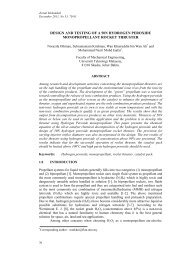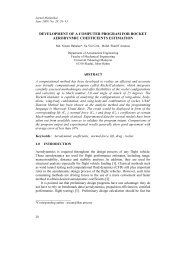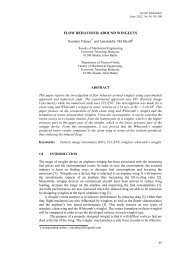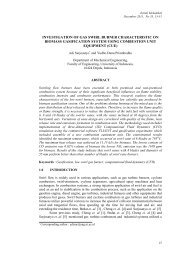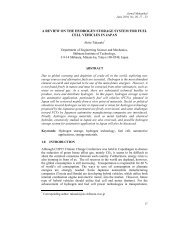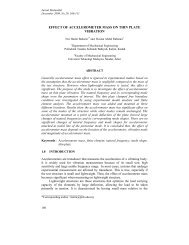structural performance analysis of formula sae car - Jurnal Mekanikal
structural performance analysis of formula sae car - Jurnal Mekanikal
structural performance analysis of formula sae car - Jurnal Mekanikal
You also want an ePaper? Increase the reach of your titles
YUMPU automatically turns print PDFs into web optimized ePapers that Google loves.
S. No.<br />
1<br />
2<br />
3<br />
4<br />
5<br />
6<br />
Table 5: Von Misses stresses and Factor <strong>of</strong> Safety<br />
Test<br />
Static Shear<br />
Static overall bending<br />
Lateral Bending<br />
Static torsional loading<br />
Acceleration test<br />
Frequency <strong>analysis</strong><br />
Von Misses Stress (N/m 2 )<br />
1.17*108<br />
2.27*107<br />
1.48*107<br />
1*108<br />
2.67x107<br />
5.53*10 10 (156.86 Hz)<br />
<strong>Jurnal</strong> <strong>Mekanikal</strong>, December 2010<br />
FOS<br />
3.18<br />
16.41<br />
25.25<br />
3.73<br />
13.97<br />
By dividing yield stress (3.73e+008 N/m 2 ) <strong>of</strong> chassis material with maximum<br />
Von Misses stresses induced in frame, factor <strong>of</strong> safety was calculated as shown in table 5.<br />
Considerable factor <strong>of</strong> safety was observed in all static (shear, bending and torsional test)<br />
boundary conditions. Chassis was found to exhibit high factor <strong>of</strong> safety during dynamic<br />
viz. acceleration test. Frame behavior was analyzed in frequency range <strong>of</strong> 69.12 to<br />
204.793 Hz and observed maximum deformation (stress and deflection), more than the<br />
yield stress <strong>of</strong> frame material at a frequency <strong>of</strong> 156.86 Hz. Below 156.86 Hz, chassis was<br />
observed to be safe and experienced stress very small than the strength <strong>of</strong> material.<br />
So, 156.86 Hz can be considered as threshold value for proposed chassis. Chassis was<br />
found to have highest factor <strong>of</strong> safety in lateral bending (25.25) followed by static<br />
bending (16.41) and dynamic acceleration test (13.97) respectively.<br />
Factor <strong>of</strong> safety was noted to be 3.73 in torsional loading mode which represents<br />
the stiff nature <strong>of</strong> frame. An ideal chassis is one that has high stiffness; with low weight<br />
and cost. If there is considerable twisting, the chassis vibrates, complicating the system <strong>of</strong><br />
the vehicle and sacrificing the handling <strong>performance</strong> [8]. The chassis that flexes is more<br />
susceptible to fatigue and subsequent failure, and “suspension compliance may be<br />
increased or decreased by bending or twisting <strong>of</strong> the chassis [9]. Also if a chassis is well<br />
designed to handle torsional loads, bending should not be an issue [9]. The torsional<br />
rigidity can be calculated by finding the torque applied to the frame and dividing by the<br />
angular deflection. The actual calculation is done as follows, with the figure 20 showing a<br />
view looking from the front <strong>of</strong> the suspension bay.<br />
K=R/Ө (1)<br />
K= (F*L)/tan-1[(Δy1+Δy2)/2L] (2)<br />
where K = Torsional Stiffness<br />
T = Torque<br />
Ө = Angular deformation<br />
F = Shear Force<br />
y1, y2= Translational displacement<br />
00<br />
59



